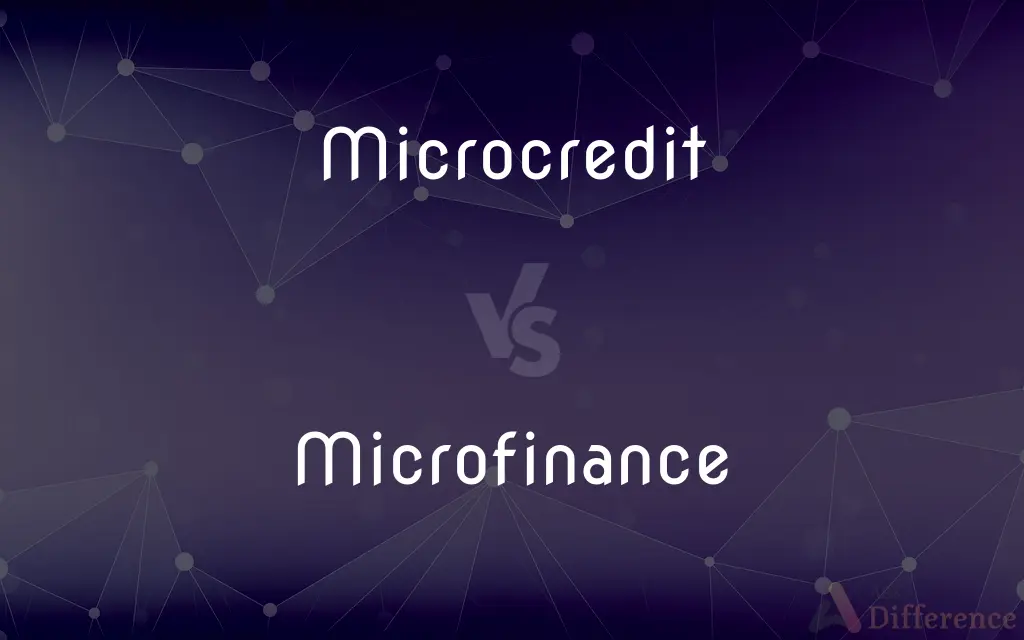Microcredit vs. Microfinance — What's the Difference?
By Tayyaba Rehman — Updated on September 19, 2023
Microcredit is a small loan to impoverished borrowers, while microfinance encompasses a broader range of financial services for the underprivileged, including savings, insurance, and loans.

Difference Between Microcredit and Microfinance
Table of Contents
ADVERTISEMENT
Key Differences
Microcredit refers specifically to the provision of small loans to individuals who are traditionally viewed as high risk by regular banking standards. Often, these individuals lack collateral, steady employment, or a verifiable credit history. Microcredit emerged as a tool to support entrepreneurship and alleviate poverty by allowing individuals to invest in their small businesses or cover essential needs.
On the other hand, microfinance is a more encompassing term. While it includes the concept of microcredit, microfinance encompasses a wider range of financial services tailored to the needs of the poor and underprivileged. Beyond just loans, microfinance institutions offer savings accounts, insurance products, and even financial training. The goal of microfinance is not just to provide capital but to bring marginalized individuals into the formal financial system.
The relationship between microcredit and microfinance is thus a subset to the whole. Think of microcredit as one of the many tools in the microfinance toolbox. The latter aims to provide a holistic approach to financial inclusion, of which credit is just a part.
Both microcredit and microfinance play critical roles in global economic development. While microcredit can ignite entrepreneurial spirit by providing the necessary capital, microfinance ensures a more comprehensive financial inclusion, allowing individuals to manage risks, save for the future, and navigate financial challenges more effectively.
Comparison Chart
Definition
Small loans provided to impoverished individuals.
Financial services, including loans, for the underprivileged.
ADVERTISEMENT
Focus
Lending only.
Lending, savings, insurance, training.
Goal
Support entrepreneurship & meet immediate needs.
Comprehensive financial inclusion.
Requires Collateral?
Typically no.
Varies, but often no.
Associated Institutions
Microcredit institutions.
Microfinance institutions (MFIs).
Compare with Definitions
Microcredit
Small-scale loans provided to those without access to traditional credit.
Rita received microcredit to start her sewing business.
Microfinance
Financial services tailored for the poor and marginalized.
Many villagers now have savings accounts thanks to microfinance initiatives.
Microcredit
Minimal loans assisting in immediate financial needs or business investments.
The local market vendors often depend on microcredit.
Microfinance
Services that encompass lending, saving, insurance, and financial education.
Through microfinance, Ravi not only got a loan but also attended financial literacy classes.
Microcredit
A subset of microfinance focusing solely on lending.
While considering microfinance options, Ali opted for microcredit to boost his startup.
Microfinance
Institutions aiming to bring underprivileged individuals into the formal financial system.
Microfinance institutions focus on both urban and rural financial needs.
Microcredit
Credit services targeting individuals without collateral or credit history.
Microcredit institutions often rely on group-lending models.
Microfinance
A comprehensive approach to financial inclusion beyond just lending.
The microfinance institution offered Maya insurance, savings, and a small loan.
Microcredit
A financial tool aimed at alleviating poverty through entrepreneurship.
Microcredit helped Sam invest in farming equipment.
Microfinance
A holistic system to combat poverty and drive economic development.
Microfinance has changed the financial landscape of many developing nations.
Microcredit
This article is specific to small loans, often provided in a pooled manner. For direct payments to individuals for specific projects, see Micropatronage.
Microfinance
Microfinance is a category of financial services targeting individuals and small businesses who lack access to conventional banking and related services. Microfinance includes microcredit, the provision of small loans to poor clients; savings and checking accounts; microinsurance; and payment systems, among other services.
Microcredit
The business or policy of making microloans to impoverished entrepreneurs. Also called microlending.
Microfinance
(finance) Finance that is provided to unemployed or low-income people or groups.
Microcredit
The practice of making very small loans, especially to poor people to promote self-employment; microlending.
Microcredit
A microloan.
Common Curiosities
Is microcredit the same as microfinance?
No, microcredit is a subset of microfinance focused on lending, while microfinance offers a broader range of services.
How do microfinance institutions ensure loan repayment?
Many use group lending models, where members collectively guarantee repayment.
Can microcredit help reduce poverty?
Yes, by supporting entrepreneurship and addressing immediate financial needs.
Can microfinance institutions offer services beyond loans?
Yes, microfinance covers savings, insurance, and even financial training.
Is collateral always required for microcredit?
Typically, no. The model often relies on trust and community ties.
Are microcredit loans interest-free?
Not always. While rates can be lower than traditional banks, there's often interest to sustain the lending model.
Who are the typical recipients of microcredit?
Often, those without access to traditional banking, including the impoverished or those without collateral.
Why is microfinance considered more holistic than microcredit?
Microfinance provides comprehensive financial services, whereas microcredit focuses solely on lending.
Can microfinance help in women's empowerment?
Yes, many programs specifically target women, promoting entrepreneurship and financial independence.
Are there risks associated with microcredit?
Yes, like any loan, there's a risk of over-indebtedness or misuse of funds. Proper financial education can mitigate these risks.
How do individuals access microfinance services?
Through microfinance institutions, often present in underserved communities.
What's the average size of a microcredit loan?
It varies by region but is typically a few hundred dollars.
How do microfinance institutions sustain themselves?
Through interest on loans, fees, and often with support from grants or investments.
Is microcredit suitable for all types of businesses?
It's best for small-scale ventures given the loan sizes.
How do microfinance institutions help with financial education?
Many provide training programs on financial literacy and business management.
Share Your Discovery

Previous Comparison
Formation vs. Training
Next Comparison
Bill vs. CheckAuthor Spotlight
Written by
Tayyaba RehmanTayyaba Rehman is a distinguished writer, currently serving as a primary contributor to askdifference.com. As a researcher in semantics and etymology, Tayyaba's passion for the complexity of languages and their distinctions has found a perfect home on the platform. Tayyaba delves into the intricacies of language, distinguishing between commonly confused words and phrases, thereby providing clarity for readers worldwide.












































